How to use work samples to assess candidates fairly

A work sample test is basically a trial run for candidates. It provides an opportunity for candidates to showcase their relevant skills, and it also gives them a realistic taste of what the job will entail. Both candidates and hiring managers gain a clear picture of whether they’re well-suited for the role. Here’s how to craft excellent work samples and assess them fairly so that you can hire the best fit, every time, even for hard-to-fill senior roles.
If you’ve been following our series on fair hiring, you’ll know how to craft a great job ad, attract a diverse pipeline of candidates, and run fair interviews to assess candidates fairly. At this point in the hiring funnel, we’ve got a strong list of finalists that tick all our boxes. But how do you identify the best fit for the role?
It’s not easy to get a sense of candidates’ working styles through interviews alone. For that level of understanding, you need a closer look at how candidates approach their work.
As soon as you meet candidates face-to-face (in person or online), your brain will start making snap judgments. These can cloud your interpretation of candidates’ potential and might lower people’s chances of success if they don’t ‘look the part’.
Work samples give you a clear window into how candidates will actually perform on the job. We recommend using work samples early in the hiring process — this way, you get a clear idea of candidates’ abilities right off the bat, and your judgments will be untainted by bias.
Don’t leave anything down to guesswork. Here’s how to use work samples to judge candidates fairly, even when hiring roles with complex responsibilities.
Did you know? Work samples are 3x more effective at identifying the best candidate than CVs.
How to design an effective work sample
The work sample test should be a realistic example of the kinds of tasks candidates would be asked to complete in their day-to-day work. Tasks should closely reflect the core responsibilities and skills in the job description. This gives candidates a chance to showcase their talent, and you an opportunity to showcase what it’s like working for your company.
If you’re hiring a social media manager, you could ask candidates to create a Twitter thread about your latest product feature. If you’re filling a vacancy in the development team, have applicants create a snippet of code to meet specifications.
Think about what skills, collaboration and styles of communication are important for you to test and design a task to explore them.

Different types of work samples
Different categories and lengths of work samples are appropriate for different roles — here are a few examples:
5 to 15–minute tasks
These work samples are a perfect filtering device for high-volume roles. You can use them as part of the early application process for candidates to complete before they submit their applications.
Here’s an example we used when hiring our Business Intern position. 900 people started the application but only 90 completed the work sample tasks! So we were left with the most dedicated 10% of candidates 😉

1-2 hour workshop
This gives you a chance to explore complex tasks with candidates and get a first-hand look at their ways of working and communicating. It’s perfect for roles that require quick-fire, strategic thinking — see our Chief of Staff example below.
Only use live work sample tests if it’s totally necessary to see how candidates work. Do you run live coding or whiteboarding exercises when hiring developers? These tests put candidates under a lot of pressure. They’re more a test of how well candidates handle anxiety than how well they can code.
There’s also a gendered divide in how candidates perform in technical interviews. In one study, all women who were given a live coding test whilst being watched by an interviewer failed the task. All women who were allowed to complete the test in private passed. If you want to be an inclusive recruiter, ditch the live code test. Opt for take-home work samples instead.
2+ hour take-home task
If the role involves independent work on clearly defined tasks, this is a perfect simulation of new hires’ day-to-day reality. There are plenty of possibilities, for example, writing a blog post, designing a web page or creating a sales presentation.
Here’s the work sample we used when hiring our Content Writer:
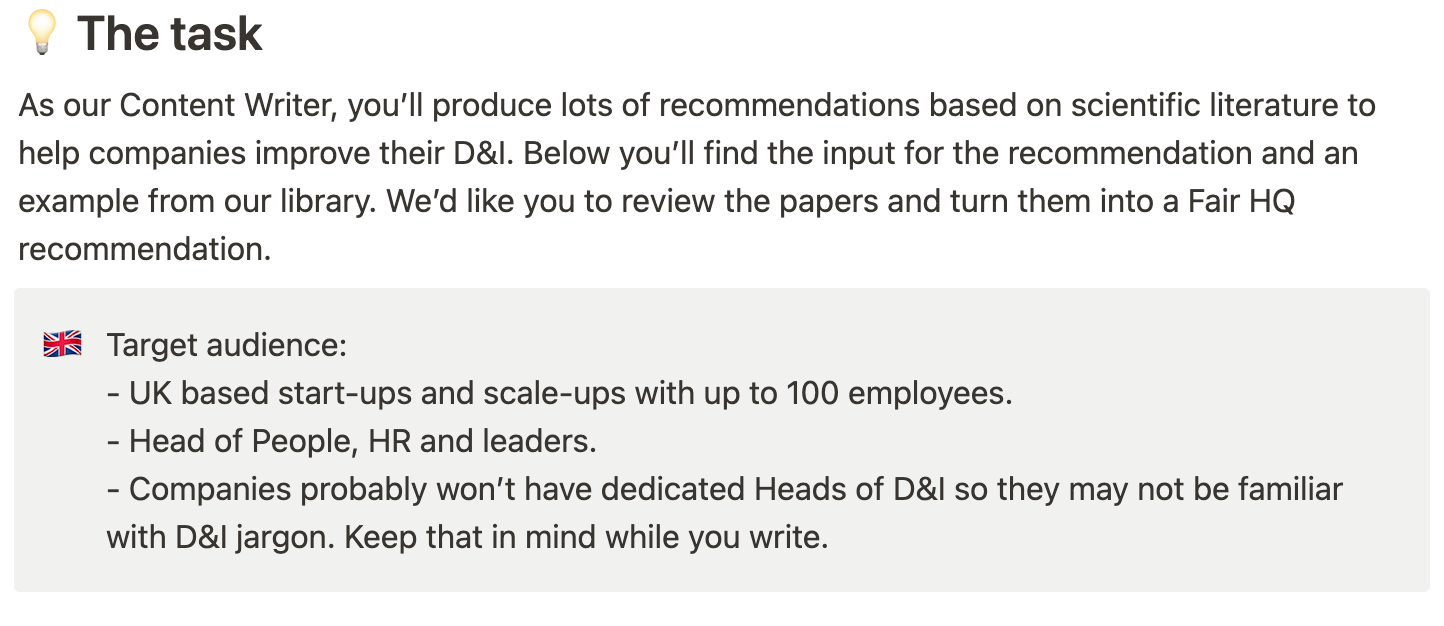
Extra tip: If the task is complex, consider offering an ‘office hour’ for candidates to talk 1-on-1 with your team about the task.
A work-day trial
For some roles, you need to be sure candidates are well suited to your company setup. For example, when hiring senior leaders with multiple responsibilities, it’s crucial to know how candidates will gel with the team.
In these trials, give candidates a longer project to work on with the team. These work samples are the most time-intensive option, but also give you the deepest insight into candidates’ potential.
For more info on designing work samples for senior roles, read on!
⚠️ Important note:
If you’re expecting people to spend above a few hours completing their work sample, the best practice is to compensate them for their time. Candidates may be put off and drop out of the process if you ask too much of them, especially those who are time-poor (such as parents and carers).
How about work samples for roles with complex responsibilities?
Not every job is easy to simulate in a stand-alone task. It’s pretty straightforward to develop a work sample for a Copy Writer, but not so much for a Chief of Staff or Product Manager… Roles like these involve longer-term projects and ongoing cross-team collaboration, which isn’t easy to test in a take-home task.
So how do we do it at Fair HQ? Let’s dive into how we hired our first-ever Chief of Staff.
We knew we had to think carefully about the skills and capabilities an ideal candidate would possess. Our Chief of Staff would sit at the centre of our company. They have to be comfortable wearing many hats — they’d be responsible for business development, hiring, finance, team happiness and much more. The ideal candidate would have to streamline their work effectively and feel energised juggling multiple priorities.
Here’s a look at the JD:
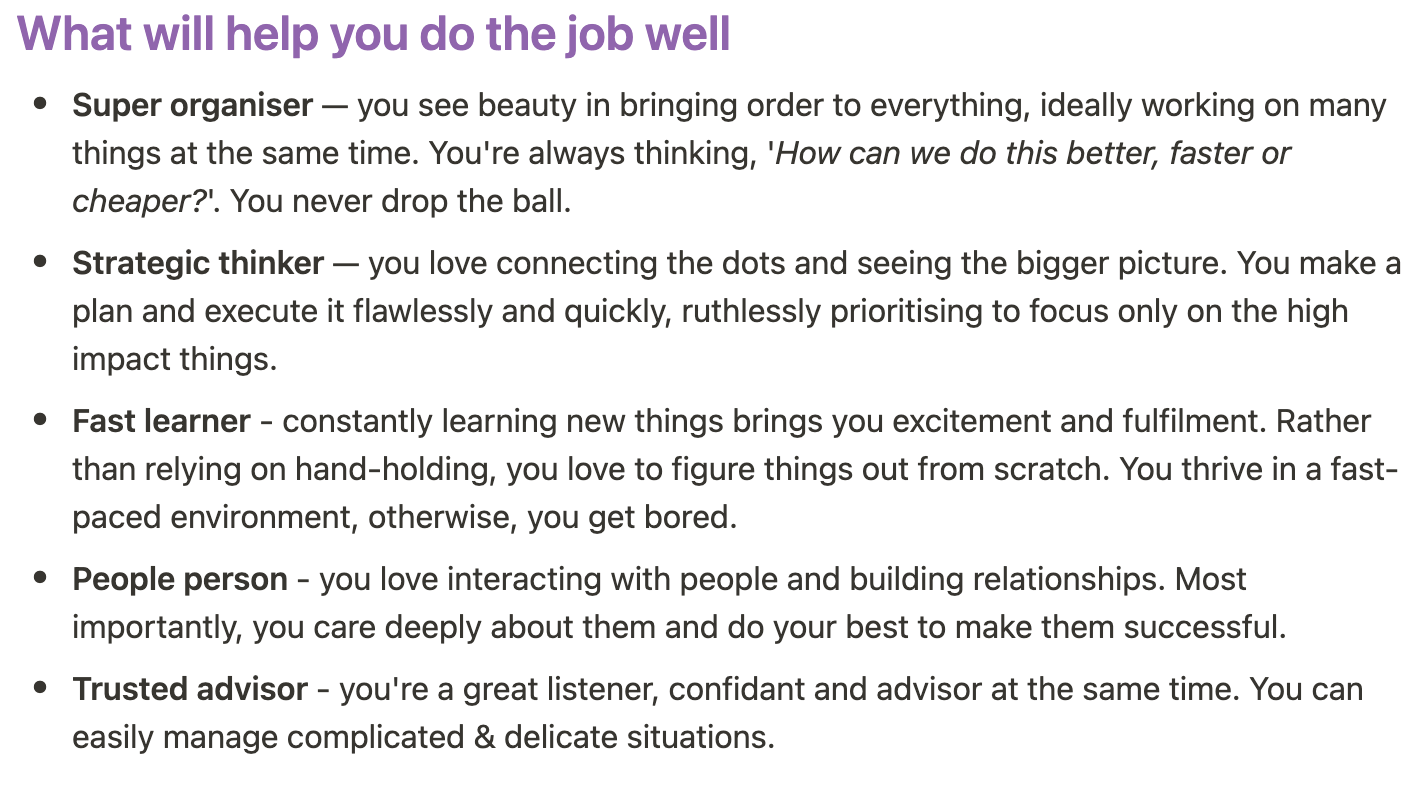
How could we design a work sample that validated these 5 capabilities at the same time? We had to think a little outside the box…
Our Chief of Staff work sample
After receiving 90 detailed application forms and conducting interviews with the 9 most impressive candidates, there were 4 final candidates for Chief of Staff who moved on to the work sample stage.
We organised a 1.5-hour workshop where we presented a task for them on the fly:

It seems pretty vague, right? That was intentional — we wanted to see if our future Chief of Staff asked the right questions, connected the dots and thought through problems logically.
They could ask as many questions as they liked during the workshop. We then asked candidates to write up their conclusion at home and then explain their decision to the team.
I know what you’re thinking: why on earth would a diversity and inclusion tech company want to know about setting up a coffee shop? Big news — we’re branching out and launching our very first Fair Cafe in 2022! ✨
Not really… although this task was miles away from what we do at Fair HQ, the activities involved were exactly what our Chief of Staff would do in their day-to-day work:
- Thinking through complex problems on the fly
- Doing their own research
- Developing strategic and creative solutions
- Clearly communicating suggestions to the team
How did we assess candidates?
We scored candidates against several criteria:
- Asking relevant questions that brought more clarity to the project
- Considering business viability – the customers, a cost/benefit analysis, the business model and strategy
- Coming up with a simple and easy solution to validate their hypothesis
- Backing up their reasoning with data (e.g. with examples from other industries)
- Uncovering the reason why we want to have a coffee shop in the first place and the true needs of the coworking space
- Thinking outside of the box to come up with a creative solution and alternatives
- Breaking down their solution into logical steps and explaining themselves clearly
- Being energized by solving complex problems as that’s the day-to-day reality of the Chief of Staff
See below for more tips on assessing work samples fairly.
This gave us a great sense of who would be up for the job of Chief of Staff. And here’s what the successful candidate has to say about the process:
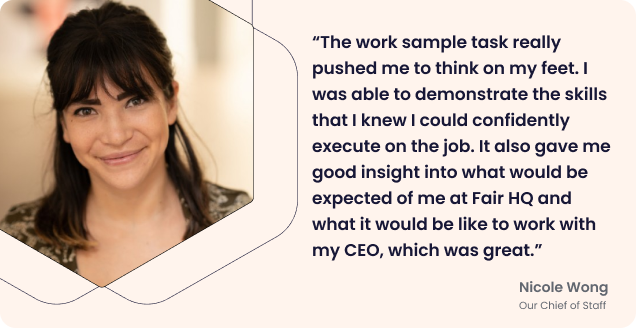
How to assess work samples fairly
Create a rating scale
We’ve said before that the key to fair assessments is consistency. To remove ambiguity from the process, craft a rating scale to guide assessors. Here’s how:
- Predefine a list of 5 to 6 skills that the work sample tests (review the job description to help you)
- Decide on a consistent rating scale (e.g. 1-5, ⭐ to ⭐⭐⭐)
- Define criteria that determine a poor, okay and great score
See an example from our Business Intern work sample below:
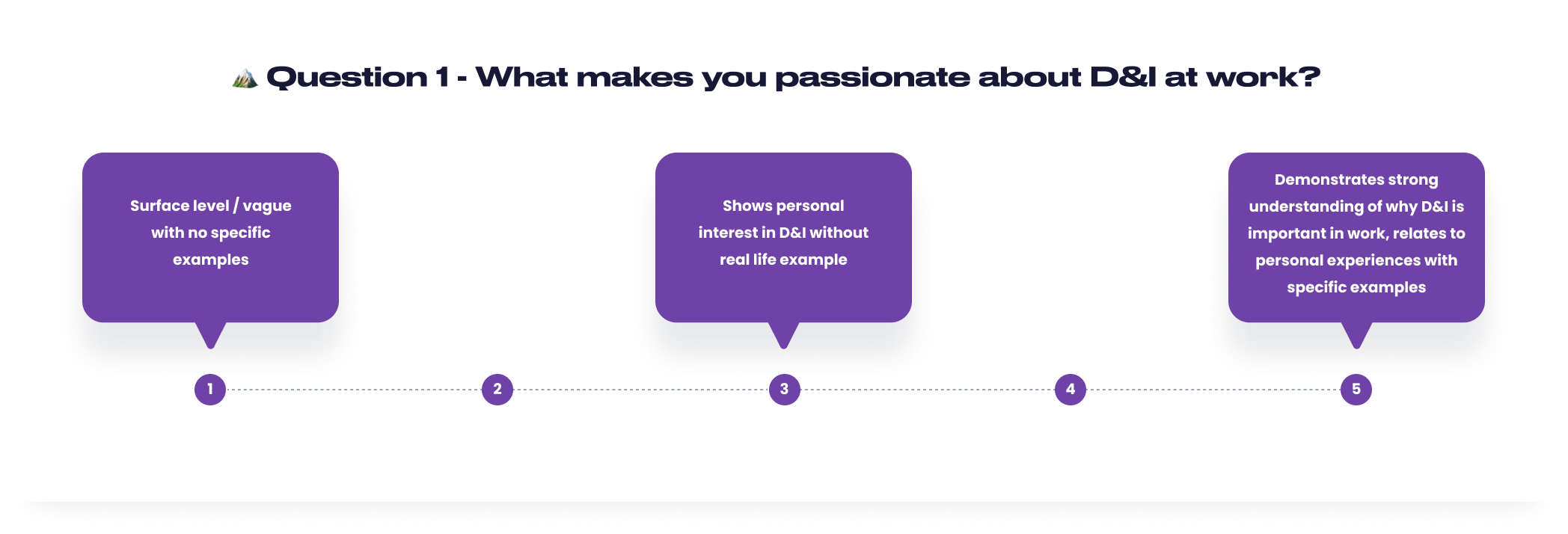
Scoring work samples
Ideally, each work sample should be scored independently by two reviewers. Never share scores between reviewers until every candidate has been rated. This will allow the reviewers to form their own opinion on candidates, rather than letting their assessments be swayed by their peers.
The order you rate answers can have a big impact on your assessments. If your work sample test involves multiple questions, then it’s important to rate responses question-by-question, not candidate-by-candidate, and hide previous scores from view. Here’s how we do it 👇
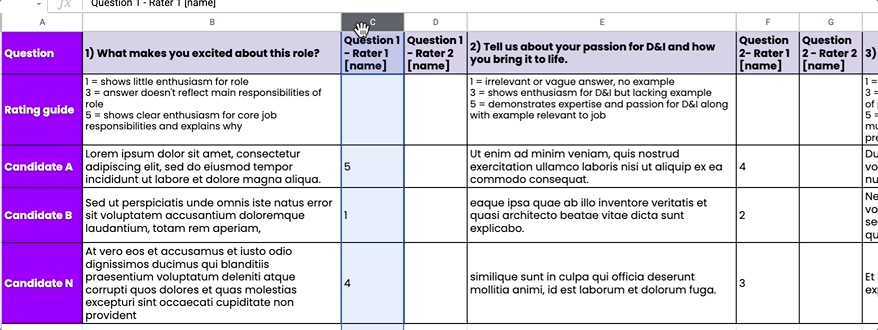
This is a great way to focus your attention squarely on performance and not have early high scores or the scores of others influence your judgements.
💡 Why should I rate question-by-question?
Harvard professor Iris Bohnet found that when assessors evaluated one candidate at a time, they were more likely to assign roles based on gender stereotypes. However, when they compared candidates to one another, they overcame this bias. Evaluating comparatively shifts the focus onto individual performance and away from stereotypes.
Work sample interviews
Once all scores have been submitted, the reviewers can meet to discuss their scores, review any discrepancies in judging, and make a final decision.
When you’ve decided who to move forward with, schedule a follow-up interview where you ask them to explain their thinking behind their work. This gives you a deeper sense of their work ethic and the way they approach tasks.
Here are some questions you can use to guide the interview:
- Talk me through your process from start to finish.
- How did you break down the task?
- How did you decide what to work on first?
- What tools did you use?
- What extra information did you seek out?
- How did you reach this decision?
Now you’re ready to start using work samples in your hiring process. Armed with this level of insight into candidates’ approach to work and relevant skills, you’ll be left with a clear front runner (it works for us every time!).
The next instalment in our fair hiring series will talk you through how to make a fair offer. Remember, work samples are just one of the ingredients to a fair hiring set-up, see our other posts to develop an end-to-end equitable hiring process.
Backing it up
Bohnet, I. (2016). How to take the bias out of interviews. Harvard Business Review, 16